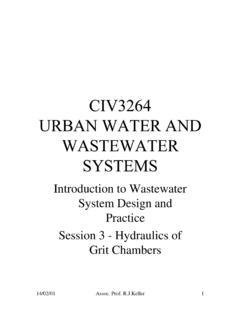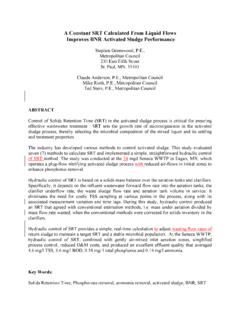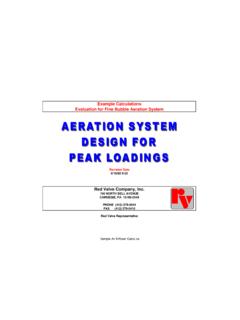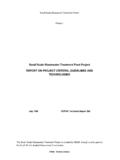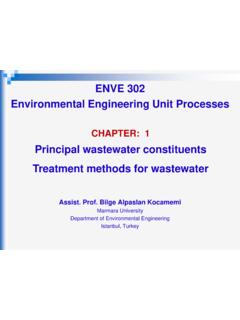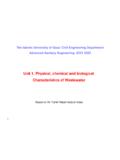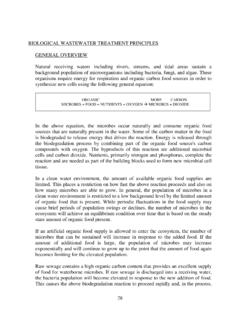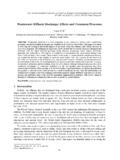Transcription of CHAPTER 6 WASTEWATER TREATMENT PROCESSES
1 TM 5 - 8 1 4 - 8. CHAPTER 6. WASTEWATER TREATMENT PROCESSES . 6-1. Preliminary and Primary Waste- further classified as manually or mechanically water TREATMENT PROCESSES cleaned. Coarse screens are used in preliminary TREATMENT , while fine screens are used in lieu of a. Introduction. Preliminary TREATMENT of sedimentation preceding secondary TREATMENT or WASTEWATER generally includes those PROCESSES as a step in advanced WASTEWATER TREATMENT . Fine that remove debris and coarse biodegradable screens as a preliminary or primary TREATMENT are material from the waste stream and/or stabilize more applicable to process or industrial wastes.
2 The WASTEWATER by equalization or chemical addi- TM 5-814-3 provides detailed descriptions of tion. Primary TREATMENT generally refers to a these units and design considerations. sedimentation process ahead of the main system (b) Comminution. A comminutor acts as or secondary TREATMENT . In domestic WASTEWATER both a cutter and a screen. Its purpose is not to TREATMENT , preliminary and primary PROCESSES will remove but to shred (comminute) the solids. remove approximately 25 percent of the organic Solids must be accounted for in subsequent load and virtually all of the nonorganic solids.
3 In sludge handling facilities. Comminutors, like most industrial waste TREATMENT , preliminary or pri- screens, are mounted in a channel and the mary TREATMENT may include flow equalization, WASTEWATER flows through them. The rags and pH adjustment or chemical addition that is ex- other debris are shredded by cutting teeth until tremely important to the overall TREATMENT pro- they can pass through the openings. Some units cess. Table 6-1 liss the typical effluent levels by require specially shaped channels for proper hy- degree of TREATMENT .
4 This section of the manual draulic conditions, resulting in more expensive will discuss the various types of preliminary and construction. TREATMENT . plant design manuals, primary TREATMENT PROCESSES available. textbooks, and manufacturer's bulletins provide b. Preliminary TREATMENT . An important part of detailed information on these units. A bypass any WASTEWATER TREATMENT plant is the equipment channel is required for all comminutors to permit and facilities used to remove items such as rags, maintenance of equipment.
5 Grit, sticks, other debris, and foreign objects. (2) Grit removal. Grit represents the heavier These interfere with the operation of the facility inert matter in WASTEWATER which will not decom- and often cause severe problems. Methods of pose in TREATMENT PROCESSES . It is identified with . removing these materials prior to primary and matter having a specific gravity of about , subsequent TREATMENT are part of a pretreatment and design of grit chambers is based on the or preliminary TREATMENT . While a summary dis- removal of all particles of about inch or cussion of the commonly employed unit opera- larger (65 mesh).
6 For some sludge handling pro- tions follows, a more complete description of cesses, it may be necessary to remove, as a design criteria which must be used is contained in minimum, grit of inch or larger (100 mesh). TM 5-814-3. Grit removal, compared to other unit TREATMENT (1) Screening and comminution. Screening PROCESSES , is quite economical and employed to and comminution are preliminary TREATMENT pro- achieve the following results: cesses utilized to protect mechanical equipment in the TREATMENT works, to aid downstream treat- Prevent excessive abrasive wear of equip- ment PROCESSES by intercepting unacceptable sol- ment such as pumps and sludge scrapers.
7 Ids, and to alter the physical form of solids so Prevent deposition and subsequent oper- they are acceptable for TREATMENT . Screening or ating problems in channels, pipes, and comminution shall always be used for military basins. domestic wastewaters. Prevent reduction of capacity in sludge (a) Screening. Screening devices remove handling facilities. materials which would damage equipment or Grit removal facilities shall be used for combined interefere with a process or piece of equipment. sewer systems or separate sanitary systems Screening devices have varied applications at which may have excessive inert material.
8 Grit WASTEWATER TREATMENT facilities, but most often removal equipment should be located after bar are employed as a preliminary TREATMENT step. screens and comminutors and ahead of raw sew- Screens are classified as fine or coarse and then age pumps. Sometimes it is not practical to locate 6-1. Table 6-1. Typical effluent levels of principal domestic WASTEWATER characteristics by degree of TREATMENT (mg/L unless noted otherwise). WASTEWATER TREATMENT . Average Advanceda Raw (1) (2) 3 (4) (5) . Parameter WASTEWATER Primary Secondary (l)+(2)+NR b (3)+PR C (4)+SSOR d BOD 300 195 30.
9 E 15 5 1. COD 600 400 150 100 45 12. e Suspended Solids 300 120 30 20 10 1. Amnonia (as N) 25 25 28 3 3 3. Phosphate (as P) 20 18 14 13 2 1. pH (units) 7 6-9 6-9e 6-9 6-9 6-9. e Fecal Coliform 1,000,000 15,000 200 200 200 100. (no. /100 mL). a Reasonable levels but not necessarily minimum for all constituents. b NR = Nitrogen Removal or Conversion C. PR = Phosphorus Removal d SSOR = Suspended Solids and Organics Removal e Environmental Protection Agency, Secondary TREATMENT Information, 40 CFR, Part 133, Federal Register, Monday, 30 April 1973.
10 TM 5-814-8. the grit removal system ahead of the raw sewage ing some of those from military industrial manu- pumps because of the depth of the influent line. facturing PROCESSES as discussed later in this Therefore, it may be required to pump the CHAPTER . Equalization reduces fluctuations of the WASTEWATER containing grit. If this mode is se- influent to levels compatible with subsequent lected, pumps capable of handling grit should be biological or physical-chemical PROCESSES . A prop- employed. erly designed facility dampens the wide swings of (a) Horizontal flow grit chambers.
